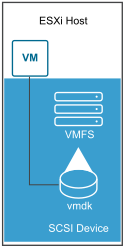Local storage can be internal hard disks located inside your ESXi host. It can also include external storage systems located outside and connected to the host directly through protocols such as SAS or SATA.
Local storage does not require a storage network to communicate with your host. You need a cable connected to the storage unit and, when required, a compatible HBA in your host.
The following illustration depicts a virtual machine using local SCSI storage.

In this example of a local storage topology, the ESXi host uses a single connection to a storage device. On that device, you can create a VMFS datastore, which you use to store virtual machine disk files.
Although this storage configuration is possible, it is not a best practice. Using single connections between storage devices and hosts creates single points of failure (SPOF) that can cause interruptions when a connection becomes unreliable or fails. However, because most of local storage devices do not support multiple connections, you cannot use multiple paths to access local storage.
ESXi supports various local storage devices, including SCSI, IDE, SATA, USB, and SAS storage systems. Regardless of the type of storage you use, your host hides a physical storage layer from virtual machines.
Local storage does not support sharing across multiple hosts. Only one host has access to a datastore on a local storage device. As a result, although you can use local storage to create VMs, you cannot use VMware features that require shared storage, such as HA and vMotion.
However, if you use a cluster of hosts that have just local storage devices, you can implement vSAN. vSAN transforms local storage resources into software-defined shared storage. With vSAN, you can use features that require shared storage. For details, see the Administering VMware vSAN documentation.